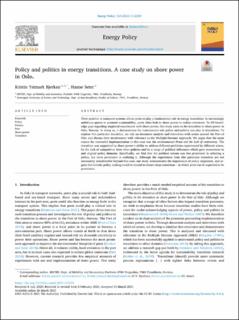| dc.contributor.author | Bjerkan, Kristin Ystmark | |
| dc.contributor.author | Seter, Hanne | |
| dc.date.accessioned | 2021-04-06T10:04:01Z | |
| dc.date.available | 2021-04-06T10:04:01Z | |
| dc.date.created | 2021-04-02T14:05:29Z | |
| dc.date.issued | 2021 | |
| dc.identifier.citation | Energy Policy. 2021. 153, . | en_US |
| dc.identifier.issn | 0301-4215 | |
| dc.identifier.uri | https://hdl.handle.net/11250/2736345 | |
| dc.description.abstract | Their position in transport systems allows ports to play a fundamental role in energy transitions. In increasingly ambitious quests to promote sustainability, ports often look to shore power to reduce emissions. To fill knowledge gaps regarding empirical experiences with shore power, this study turns to the transition to shore power in Oslo, Norway. In doing so, it demonstrates the instrumental role policy and politics can play in transitions. To explore this particular transition, we rely on document analysis and interviews with actors around the Port of Oslo and discuss their involvement with reference to the Multiple-Streams Approach. We argue that the main reason for successful implementation in this case was the environmental thrust and the lack of controversy. The transition was supported by shore power's ability to address different problems experienced by different actors, by the lack of competition from other policies and by a range of political influences which gave momentum to and aligned policy domains. Specifically, we find that the political stream was less prominent in selecting a policy, but more prominent in realizing it. Although the experiences from this particular transition are not necessarily transferrable beyond this case, our study demonstrates the importance of policy alignment, and argues that holistic policy making could be crucial to ensure deep transitions – in which ports can be expected to be prominent. | en_US |
| dc.language.iso | eng | en_US |
| dc.publisher | Elsevier | en_US |
| dc.rights | Navngivelse 4.0 Internasjonal | * |
| dc.rights.uri | http://creativecommons.org/licenses/by/4.0/deed.no | * |
| dc.title | Policy and politics in energy transitions. A case study on shore power in Oslo | en_US |
| dc.type | Peer reviewed | en_US |
| dc.type | Journal article | en_US |
| dc.description.version | publishedVersion | en_US |
| dc.source.volume | 153 | en_US |
| dc.source.journal | Energy Policy | en_US |
| dc.identifier.doi | 10.1016/j.enpol.2021.112259 | |
| dc.identifier.cristin | 1901979 | |
| dc.relation.project | Norges forskningsråd: 281002 | en_US |
| dc.description.localcode | This is an open access article distributed under the terms of the Creative Commons CC-BY license, which permits unrestricted use, distribution, and reproduction in any medium, provided the original work is properly cited. | en_US |
| dc.source.articlenumber | 112259 | en_US |
| cristin.ispublished | true | |
| cristin.fulltext | original | |
| cristin.qualitycode | 1 | |

